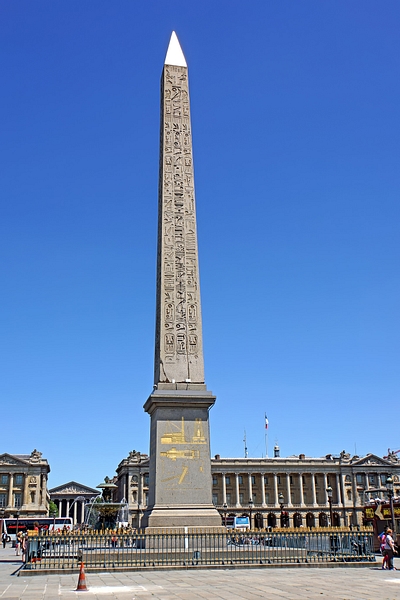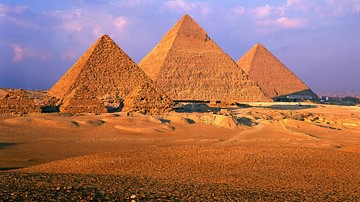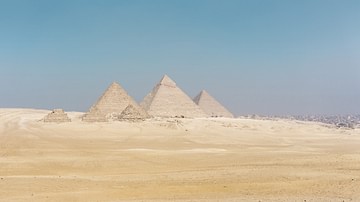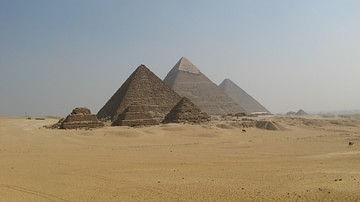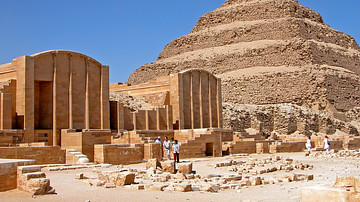
An obelisk is a stone rectangular pillar with a tapered top forming a pyramidion, set on a base, erected to commemorate an individual or event and honor the gods. The ancient Egyptians created the form at some point in the Early Dynastic Period (c. 3150-c. 2613 BCE) following their work in mud brick mastaba tombs and prior to the construction of the Step Pyramid of Djoser (c. 2670 BCE). It is thought that the earliest obelisks served as a kind of training for working in stone on monumental projects which was a necessary step toward pyramid building.
The name "obelisk" is Greek for "spit", as in a long pointed piece of wood generally used for cooking, because the Greek historian Herodotus was the first to write about them and so named them. The Egyptians called them tekhenu which means "to pierce" as in "to pierce the sky". The earliest obelisks no longer exist and are only known through later inscriptions but appear to have been only about ten feet (3 metres) tall. In time they would reach heights of over 100 feet (30 metres). Although many cultures around the world from the Assyrian to the Mesoamerican employed the obelisk form, only ancient Egypt worked in monolithic stone, almost always red granite. Each ancient Egyptian obelisk was carved from a single piece of stone which was then moved to its location and raised onto a base. While archaeologists and scholars understand how these monuments were carved and transported, no one knows how they were raised; modern day efforts to replicate the raising of an obelisk, using ancient Egyptian technology, have failed.
Symbolism of the Obelisk
The obelisks of ancient Egypt represented the benben, the primordial mound upon which the god Atum stood at the creation of the world. As such, they were associated with the benu bird, the Egyptian precursor to the Greek phoenix. According to some Egyptian myths the benu bird was the first living creature whose cry awoke creation and set life in motion. The bird was linked to the morning star and the renewal of each day but was also the sign of the end of the world; in the same way the bird had cried to begin the creative cycle, she would sound again to signal its completion.
The Egyptians believed a day would come when the gods would die and all would return to the uniformity of primordial chaos. The benu bird would not choose this end of its own but would be given its cue by the sun god Ra who, in turn, would have been informed by the god Thoth, keeper of the records of humans and gods. The benu bird was primarily linked, however, with Ra (later Amun and Amun-Ra) and with light and life. Egyptologist Geraldine Pinch comments on this:
From the Pyramid Texts onward, the benu bird was closely associated with the creator sun god. In Heliopolis, the center of solar worship, the benu bird was said to perch on the benben stone, a kind of primitive obelisk, or in the branches of a sacred willow tree. When Egyptian kings had reigned for thirty years, they asked the benu bird to renew their strength and vitality (117).
While keeping its association with the benu bird, the obelisk came to be increasingly associated with Ra and solar worship, especially from the New Kingdom (c. 1570-1069 BCE) onwards. Obelisks were always raised in pairs in keeping with the Egyptian value of balance and harmony; it was believed that the two on earth were reflected by two in the heavens. Egyptologist Richard H. Wilkinson writes:
The phenomenon of duality pervades Egyptian culture and is at the heart of the Egyptian concept of the universe itself. But rather than focusing on the essential differences between the two parts of a given pair, Egyptian thought may stress their complementary nature as a way of expressing the essential unity of existence through the alignment and harmonization of opposites - just as we today might use "men and women", "old and young", or "great and small" to mean "all" or "everyone" (129).
The dual obelisks were raised in honor of a great king's accomplishments (or, in the case of Hatshepsut, a great queen), but also served to honor the gods or, more often, a specific god. In the period of the New Kingdom the obelisk was thought to be inhabited by the spirit of the god it was raised for in the same way a god was thought to actually live in his or her temple. Thutmose III (1458-1425 BCE) of the New Kingdom instituted the ritual of offering ceremonies to obelisks in the same way that offerings were brought to temples and this practice continued through the Ptolemaic Period (323-30 BCE), the last to rule Egypt before it was annexed by Rome. The pharaohs of the New Kingdom erected more obelisks than any other in the belief that they would live on through these monuments as offerings would continue to be brought to them after their death.
The obelisks, then, represented the living deity, the vitality and immortality of the pharaoh, and the concept of duality and balance. No matter who or what else they commemorated, though, they were raised and carefully positioned so that the first and last light of day would touch their peaks to honor the sun god. The sun god was thought to enter on a perilous journey at night where he would have to navigate his barge through the underworld and avoid destruction by the great serpent Apophis. The Egyptians performed ceremonies to ward off and weaken Apophis and keep the sun god safe and, in this way, they took part in the cycle of day and night. Obelisks served to honor the sun god as he rose from night in the morning, crossed the sky, and disappeared back into darkness at evening. On a practical level, the obelisk would have then served as a sun dial in that the journey of Ra across the sky would have been indicated by the movement of the shadow of the monument except when the sun was directly overhead and no shadow would be cast.
Construction & Placement
The largest obelisk ever created was never raised: the so-called "unfinished obelisk" of the pharaoh Hatshepsut (1479-1458 BCE) which still rests where it was abandoned at the quarry of Aswan, the site regularly used for quarrying stone for such monuments. The unfinished obelisk is thought to have been commissioned for placement at Karnak, where Hatshepsut had already raised the monument known today as the Lateran Obelisk which was moved to Rome in the 4th century CE by Constantius II. The unfinished obelisk measures 137 feet (42 metres) and is approximated to weigh 1,200 tons. Work on the monument was abandoned when it cracked while being carved and so it remains, in situ, just as it was left thousands of years ago when the workers walked away from it. Marks from ancient tools and worker's measurement-markings are clearly visible on the piece and provide insight into how obelisks were quarried.
Workers began carving an obelisk out of the granite bedrock at Aswan using chisels and wooden wedges. Egyptologist Rosalie David explains:
Evidence at Aswan indicates that to remove the stone the masons probably chiseled holes into the rock to a depth of about six inches and then forced wooden wedges into these holes before moistening them with water so that the wood swelled and caused the rock to split. The obelisk could then be chiseled out and transported by river to the site of the temple, where it was finished (171-172).
The tools used were metal, such as copper, and stone. Volcanic rock (Diorite) was also used to loosen the stone once holes had been made. David takes note of Flinders Petrie's discoveries that "metalsmiths were adept at judiciously adding certain alloys to metals to make them suitable for particular tasks; they also tempered them and thus were probably able to produce tools of required strength to deal with all those stones" (172). It is unknown exactly how long it took workers to quarry and shape an obelisk but the entire process, from initial quarrying to transport to raising of the monument, took approximately seven months. Historian Margaret Bunson describes the process of moving an obelisk from the quarry at Aswan to its destination at Thebes:
When the pillar was carved to satisfaction, ropes were slung around it and the stone was raised and placed on a heavy sledge. It took several thousand workmen to pull the sledge to the banks of the Nile. There, vessels waited in dry docks specially designed to allow safe loading of the pillars. The unique aspect of this loading process is that the boats remained in dry dock until the pillars were safely on board. Then the vessel and the sacred cargo were slowly floated on water emptied into the dock. When the ship and the pillar were stabilized, the dock gates were opened and the vessel made its way out onto the Nile. Nine galleys, each with more than 30 rowers, towed the vessel and the obelisk to Thebes where a ceremonial ritual and vast crowds awaited their arrival. A ramp was prepared in advance and the pillar was pulled to the incline. The unique part of the ramp was a funnel shaped hole, filled with sand. The obelisk was positioned over the hole and the sand was emptied, thus lowering the pillar into place. When the obelisk had been positioned on its base and fastened there, the ramp was removed and the priests and royal household arrived to take part in dedication rituals and in ceremonies in honor of the god of the stone (194-195).

The quarrying, transport, and raising of an obelisk is well documented through inscriptions, drawings, and official letters on the subject but no specific mention is made of how exactly the obelisk was raised to position on its base. Bunson's description of the funnel-shaped hole draws on ancient Egyptian sources which would seem to indicate that the base of the obelisk was beneath the ramp and covered with sand. The bottom of the obelisk would be positioned over this hole and sand removed slowly to raise the monument while, presumbably, workmen with ropes carefully guided the obelisk as it rose.
The ancient Egyptian inscriptions on this part of the process are unclear, however, and the problem with assuming the funnel-shaped hole in the ramp clarifies anything is that this hole would have to have been of considerable depth to aid in raising a 100 foot tall monument, there would have to have been some kind of groove to prevent slippage on the base, and workers would have needed to find some way to pull the obelisk upright once it had attained a certain height and angle; modern attempts to replicate this process have failed. In 1995 CE a NOVA team with archaeologist Mark Lehner attempted to raise an obelisk based on the Egyptian sources and failed. When they used more modern techniques they failed as well. The funnel-shaped hole of sand would only have had to be deep enough to bring the edge of the bottom of the obelisk down to the edge of a groove in the base but this did not work. Further, the angle of the obelisk as it was rising stopped at 40 degrees and the modern-day workers with their ropes could find no way to raise it further.
In 2001 CE, abandoning the ancient sources, aeronautics professor Mory Gharib and a team raised a 6,900 pound obelisk using kites, a pulley system, and a support frame. Harnessing wind power and calculating leverage needed for the pulley system carefully, the obelisk was raised in 25 seconds. Gharib claims that this was most likely how the ancient obelisks were raised as well as how the pyramids and temples of Egypt were built. This claim, however, is entirely speculative as there are no records indicating a use of kites in construction in ancient Egypt.
Bunson's description, although specifically citing Thebes, would have applied to any of the sites where obelisks were found. Although they were primarily raised at Karnak they were also positioned outside of many temples from Heliopolis (near modern Cairo) in Lower Egypt to Elephantine in Upper Egypt near Aswan.

Obelisks & Temples
Obelisks were frequently positioned in the courtyards of temples to honor the god within as well as the sun god who would sail overhead. The only obelisk still standing in its original position is that of Senusret I (c. 1971-1926 BCE) at the site of a former temple to the sun god at Heliopolis. Other obelisks were removed by foreign nations or given as gifts to countries by the Egyptian government in the modern era. Inscriptions and documentation, however, make clear that obelisks were a regular feature of temples throughout ancient Egypt. Wilkinson states:
Symbolic orientation and placement can perhaps be most easily seen in the Egyptian temple, where it was employed constantly at both the macro and micro levels. Many temples were located on sacred sites or built close enough to the Nile to be partially submerged during the river's annual flooding, thus symbolic of the watery creation of the world. Certain late temples also had shrines built on their roofs and crypts below ground level, probably symbols of heaven and the underworld. Most temples were aligned, at least theoretically, with the daily passage of the sun. This alignment is seen in the positioning of the horizon-like pylons, towering obelisks, and solar disks painted along the architraves of the temple's east-west axis (66).
These obelisks would have been carefully measured and cut to conform to the size of a particular temple and the position they would take up there. The point of the pyramidion top of the obelisk was supposed to catch the first and last sun's rays and so the monument had to be high enough and positioned in such a way to accomplish that. The location of the obelisk and its height was the responsibility of the king who would commission both the temple and the complex surrounding it. Wilkinson writes:
From the very foundation of a temple, the king played the dominant role in its construction and functioning. Individual monarchs were responsible for building the successive pylons and courts added to Egypt's greatest temples and even complete structures in other cases. Representations show the king involved in a foundation ritual known as "stretching the cord" which probably took place before work began on the construction of a temple or of any addition. These depictions usually show the king performing the rite with the help of Seshat, the goddess of writing and measurement, a mythical aspect which reinforced the king's central and unique role in the temple construction (174).
Ramesses II (the Great, 1279-1213 BCE) commissioned the greatest number of obelisks for temples and encouraged the continued practice of presenting offerings to them. He positioned his obelisks at the Temple of Amun at Thebes in Upper Egypt down to Heliopolis in Lower Egypt and no doubt had others in his city of Per-Ramesses at the site of the former city of Avaris. Large portions of Per-Ramesses ("the city of Ramesses") were dismantled for the construction of Tanis under the reign of Smendes (c. 1077-1051 BCE) after the Nile changed course and left the former city without a water supply.
Throughout the Third Intermediate Period (c. 1069-525 BCE) Tanis was an important city designed to mirror the much older Thebes and while it is possible obelisks were created for the city at this time it is more probable they were moved from the city of Ramesses. As in every aspect of the construction and positioning of obelisks, the amount of effort to accomplish this would have been considerable but it seems, to the Egyptians, the monuments which pierced the sky and honored the gods were worth the trouble. The rest of the world would seem to agree as Egyptian obelisks, or imitations of the form, can be seen prominently displayed in many modern cities in the present day.
